Friends of the Arboretum Newsletter
Volume 10, Number 1
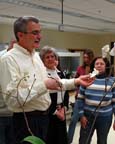 |
 |
 |
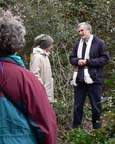 |
Arboretum Update
Welcome New Director – Denny Werner, Ph.D.
By Julia Kornegay, Ph.D., Head, Department of Horticultural Science, NC State University and Nancy Doubrava, Interpretive Specialist
The JC Raulston Arboretum is pleased to welcome its new director, Denny Werner, Ph.D., who began his duties on December 1, 2005. He is a professor in the Department of Horticultural Science at NC State and a long-time collaborator and member of the Arboretum. He is the third director of the Arboretum following Bob Lyons, Ph.D., and the late J. C. Raulston, Ph.D.
Born and raised in York County, Pennsylvania, Denny began gardening at an early age. His interests in gardening and plants led him to major in horticulture at Pennsylvania State University, where he received a B.S. degree in 1973. At Michigan State University, he earned both an M.S. in horticulture and completed his Ph.D. degree in horticulture in 1979. Denny's interests and studies throughout his college career have been in plant breeding and genetics.
Research Interests
The Department of Horticultural Science has been fortunate to have Denny as a faculty member since 1979 with responsibilities in teaching and research in peach breeding and genetics. He was promoted to professor in 1988. His efforts in peach breeding have led to the development of numerous peach cultivars which are widely grown in the southeastern United States. These cultivars are highly regarded for their late blooming, cold hardiness, eating quality, and novel fruit characters, such as low acidity and white flesh. His work has also contributed to our knowledge of the genetics of many of the traits found in peaches. One result of his research was the development and release of the Corinthian series of fastigiate ornamental peaches.
More recently, his research efforts have shifted to ornamental plant breeding and genetics, focusing on Cercis, Buddleja, and Stokesia. He has made considerable progress in developing improved ornamental forms of Cercis, focusing on the manipulation of genes controlling plant architecture, flower color, and leaf color and variegation. His work in Buddleja has focused on sterility, compact growth habit, and expansion of the color palette in this plant group. Current efforts in Stokesia have addressed the development of improved architectural types in a range of flower colors.
Teaching Contributions
Denny has been heavily involved in undergraduate and graduate teaching, advising students, and departmental administration. He received the NC State University "Outstanding Teacher" award in 1999 and 2003, and was named the "Outstanding Academic Advisor" in the College of Agriculture and Life Sciences in 1999. He has served as a mentor and advisor for numerous undergraduate students participating in independent research, and was recognized by the University Honors Council in 2003 for his contributions in this area.
He served as the Department of Horticultural Science graduate program director for 11 years and has advised 13 M.S. and Ph.D. graduate students. Teaching responsibilities have included Tree Fruit Culture and Physiology, Graduate Student Seminar, Basic Agricultural Genetics, Gardening with Herbaceous Perennials, Introductory Plant Propagation, and Breeding Asexually Propagated Plants.
Hard at Work
Guidelines for Collecting Propagation Material from the JC Raulston Arboretum The JC Raulston Arboretum is pleased, as it always has, to be a resource for commercial nurseries to obtain propagation material. In order for us to continue to offer this service, it is important for the Arboretum to monitor how our resources are being used. Please use the following guidelines when collecting at the JCRA:
|
It is easy to see that Denny has a passion for the Arboretum. For months before his official starting date, you could find him each Monday at the Arboretum meeting with the interim director, Kim Powell. Denny has watched the Arboretum grow since its infancy and has an excellent understanding of its many roles and the diverse audiences it reaches. With a quiet charm and a gentle smile, he is successfully bringing together many diverse groups to achieve a common goal.
His impact as director has already been felt. He immediately doubled the number of Friends of the Arboretum Lectures and added several outstanding workshops. He is working closely with the many groups that make up the North Carolina green industry. Management of the Arboretum's collections and acquisitions is another high priority, and he's already formed a woody plant advisory group to assist with this. Impressively, he's met with each staff member and many volunteers individually, listening and sharing ideas. It has been a busy and exciting time, getting the Arboretum's propagation house ready; organizing the Perennial Border expansion; working with design volunteers on landscaping projects, and hiring new staff. Fortunately for the JCRA, this list of accomplishments can go on and on...and it will only continue to grow.
Words from the Director
Director's Letter
By Denny Werner, Ph.D., Director
Greetings from the JCRA. My first two months at the JCRA have been very busy, but it's been exciting working with the staff developing plans for the Friends of the Arboretum programs for the this year. We've put together a wonderful offering of FOA Lectures and workshops for both winter and spring and we hope you have the opportunity to join us for some, if not all, of the remaining programs. It has been a great pleasure to have the opportunity to meet so many of you at these events. Please forgive me if I have difficulty remembering all of your names and faces, but I promise you that over time I will.
I'm writing this message on Saturday afternoon, January 27, just a few hours after having worked with the staff and a team of volunteers, cutting back and mulching the herbaceous perennial border at the JCRA. That so many volunteers would sacrifice their own time to come and assist on a Saturday morning demonstrates the caring nature and concern that all of you have for the JCRA. I have watched the JCRA evolve over the last 27 years from a locally recognized treasure to a nationally known garden. That growth and evolution would not have been possible without the care, concern, and assistance of so many people.
The unusually warm weather this January has resulted in considerable bud development on many plants here at the JCRA. Many cultivars of Prunus mume are flowering and some Narcissus began to flower about a week ago. Here's hoping we don't have a repeat of the circumstances of winter 2005 when weeks of unusually warm weather followed by a cold snap resulted in injury to many landscape plants. After 27 years in North Carolina, I have learned there is no such thing as a "normal" winter.
The staff is quite busy propagating many conifers and broadleaf evergreens for the fall plant giveaway and next year's Connoisseur Plants program. Thanks to the staff and former staff for their role in last year's Connoisseur Plants program. We are currently sorting all of your Connoisseur orders, and by now, most of you have probably received your plants. We hope that you will enjoy them; please let us know how they have performed for you in your garden.
I had the opportunity to speak at the Southern Plant Conference in Louisville, Kentucky, in October 2005. This biennial conference always includes a great line-up of speakers, and attracts a wonderful group of plant enthusiasts. Some of the keynote speakers at the Southern Plant Conference included Alan Bush; Peter Del Tredici, Ph.D.; Mike Dirr, Ph.D.; Mike Hayman; Todd Lasseigne, Ph.D.; Tom Ranney, Ph.D.; and Don Shadow. The JCRA is pleased that some of these great plantsmen have agreed to speak at our JCRA 30th Anniversary Symposium from September 22-24, 2006. Please mark these dates on your calendar, as this is an event you don't want to miss! See more details in our events section later in the newsletter.
Attending the Southern Plant Conference, and a few months later walking the trade show floor at the Green and Growin' Show, I'm overwhelmed at the number of new plants being introduced in the trade. There is magnificent plant material being offered, and sorting through all of these new plants and trying to determine which ones to trial here in the collections of our small arboretum is challenging. To assist the staff and myself in decisions regarding the JCRA woody plant collections, (including plant acquisition priorities, removal of existing plants from the collection, and decisions regarding which genera to feature in comprehensive collections), I have assembled a woody plant advisory group comprised of Tony Avent, Rick Crowder, Mike Dirr, and Bryce Lane, and the yet-to-be named assistant director of the JCRA. I sincerely appreciate the willingness of these individuals to serve in this important capacity. It is a daunting task with just eight acres of land and such a large "wish list." At this time, discussions are also underway to identify a process for the development of a landscape master plan, a critical need for the JCRA. As we make progress in this area, more information will be provided.
Many of you have asked me about the future of the old brick house on the grounds of the JCRA, as, like me, you have fond memories of this structure. I understand that complete renovation of the structure had been considered during the past few years, but the cost of renovation was prohibitive for the JCRA. A final decision was made to demolish the old house because the structure in its current state is unattractive and deteriorating, and the uncertainty of its future was limiting our ability to establish new plantings in the area around the structure. The final decision has been made by the JCRA and the University to begin demolition, with initial steps such as asbestos removal and disconnecting of utilities to begin shortly. Demolition of the building itself is scheduled for late spring to early summer.
Finally, I want to take the opportunity to thank all of you who so generously give of your time and money in support of the JCRA collections and programs. As I stated in an earlier JCRA e-Update communication to the membership, I want to thank all of you who have so kindly welcomed me to the JCRA. Your expressions of support for me, the staff, and for the gardens and programs of the JCRA are greatly appreciated. The Arboretum is a special place to me, as it is for all of you. I'm heartened and grateful for the offers of assistance that I have received, and I look forward to meeting and getting to know each of you. I'm honored to have the opportunity to be the director of the JCRA, and with your help, passion, and support, I look forward to charting a future course for your JC Raulston Arboretum. Yes, an arboretum is about the plants, but it is also about the people who care about the JCRA and its plants, and the incredible satisfaction that we all derive from working in the earth, working with plants, and interacting with other people who love plants and the JCRA. Take care, and please drop in and say hello the next time you are at the JCRA. Visit often.
Werner's Wanderings – Miscellaneous Notes from the Director
By Denny Werner, Ph.D., Director
Verbena bonariensis Seed Germination
Verbena bonariensis (Brazilian verbena or Verbena on-a-stick as Tony Avent likes to call it) is a great, easy-to-grow herbaceous perennial. I'm sure many of you grow it in your home landscapes. In spite of the fact that it does seed itself about the garden quite readily, it is often difficult to germinate the seed efficiently in a greenhouse or controlled setting. Germination is often poor and erratic. I recently had an undergraduate student in the horticulture department, Andrea Weber, conduct an experiment examining the effect of gibberellic acid (GA3) treatment on seed germination of V. bonariensis. Andrea treated seed with GA3 in solution at concentrations of 0, 125, 250, 500, or 1,000 ppm GA3. Seeds were sown on filter paper disks housed in plastic petri dishes; dishes containing the seed were placed at a temperature of 76°F-78°F in a growth room. Seven days after sowing, seed from all GA3 treatments germinated well, ranging from 9% to 52%. No seed germination was observed in the untreated group, even at 21 days after sowing. Some seedling distortion occurred at the 1,000 ppm treatment, so the 250 or 500 ppm concentrations are recommended.
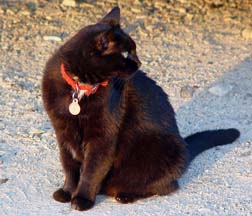 Mittens the Cat
Mittens the Cat
Mittens, the black Arboretum cat, has been adopted by one of our volunteers, Carolyn Fagan. Mittens is getting up in years, and the decision was made that Mittens would be happier leading a life of luxury as an indoor cat where she could be given care and attention 24-7. We appreciate Carolyn's willingness to adopt and care for Mittens.
Gardening Fatigue?
A piece in the January 12, 2006 edition of the New York Times entitled "Baby Boomers, Digging Ben-Gay," by Anne Raver, was brought to my attention by various members. The article discussed the decline in nursery crop and seed sales since 2002, the trend toward simplicity in home landscapes, and the preference by consumers for rugged, carefree plants like hydrangeas and butterfly-bushes. Although sales of lawn and garden products are down, Anne related that money spent on landscaping services has risen steadily. She further related that many in the "younger generation" have not developed the interest and passion for gardening like many of the baby boomers, and that the gardening interests of the younger generation revolves around "instant gratification" products like planned gardens, and potted and container gardens.
Certainly, many factors influence the trends discussed by Anne. I am not a sociologist, but my intuition is that the lack of regular exposure to nature and the natural world in the younger members of our society is one such factor. My interest in plants and gardening developed as a consequence of my daily exposure as a child to the fields, woodlots, and open spaces of southern Pennsylvania. A recent book, called to my attention by colleague Pat Lindsey, Ph.D., in the Department of Horticultural Science, is, I believe, germane to this issue. It is entitled Last Child in the Woods: Saving our Children from Nature Deficit Disorder by Richard Louv. In this thought provoking book, Richard argues that the lack of exposure to nature has a serious impact on the emotional development of youth, and outlines the consequences our children and our society face as a result of this disconnect between children and the natural world. It's a good read.
Dinosaurs and Grass
Past thinking on the evolution of members of the grass family, Poaceae, suggested that grasses did not emerge until after the age of the dinosaurs. An article in a recent issue of the journal Science (November 2005) challenges that theory. Dinosaurs are thought to have gone extinct about 60 to 65 million years ago, and previously the oldest grass fossils ever found were about 55 million years old. Researchers from Sweden and India have examined fossilized dung from a group of dinosaurs called sauropods that existed 65 to 71 million years ago. Analysis of sauropod dung (called coprolites if you want to talk about this at your next social event) showed evidence of grasses that included relatives of rice, bamboo, and forage-type grasses. The authors hypothesize that grasses must have originated well over 80 million years ago to account for the diversity of types found in the dinosaur diet.
Horticulture
Reflections of a Plant Explorer
By John Creech, Ph.D., Former Director, United States National Arboretum
Denny Werner, Ph.D., asked if I would contribute a short piece for the JC Raulston Arboretum Newsletter, and I pondered awhile. Then I thought, "Why not reflect on my own history, beginning in 1955?"
I "grew up" in the Office of Foreign Plant Exploration, USDA, at the Plant Introduction Garden in Glenn Dale, Maryland. This was a major facility for the first stop of prohibited plants coming into the United States from all foreign countries. When I arrived, there was in quarantine a prohibited flowering cherry bonsai plant presented to Admiral Chester W. Nimitz by a counterpart Japanese admiral. Being in soil, it was restricted and had been in quarantine for about two years. Finally, it was released and a Navy officer arrived to collect the plant. Out came a fine-looking bonsai with a huge branch. Our propagator proudly commented that he guessed that was the right way to grow this plant!
Later, when I returned from a foreign trip to collect plants, the first thing I did was rush to see how my collections were doing. Times have changed in the way plant explorers collect. When I first worked in Glenn Dale, collectors sent live plants shipped in Wardian cases (a kind of portable greenhouse) or cuttings wrapped in waxed paper. They had no way of knowing if their collections had survived the long journey home. Now shipments are wrapped in sphagnum moss and wonderful plastic bags, and air shipments mean days instead of months to get plants back to the United States.
But collectors are just the first step in the field of plant introduction. So many people are involved: the botanists, the plant propagator, the geneticists, the documenters (those who keep plant records), and others – more than just the collector himself. For example, when I collected Lagerstroemia fauriei from remote Yakushima, Japan, I only knew it was a rare species with brilliant reddish bark. Seed was raised at Glenn Dale and distributed (including three now growing at the JC Raulston Arboretum, one of which is named 'Fantasy'), but I could not know its unusual resistance to powdery mildew. Only after observations was this feature discovered by Don Egolf, Ph.D. He used it in hybridization, and developed the popular variety we now know as 'Natchez'.
People often are unaware of how long it may take a plant to attract notice – sometimes years. I once picked up Sedum spurium from the Central Siberian Botanic Garden near Novosibersk, Russia, in August of 1971, and noted it was an excellent groundcover. It had very tiny leaves and bright pink flowers, and eventually was named 'John Creech' by Andre Viette. At first, it was sold as Sedum sp., but in 2002, Tony Avent helped determine that it was S. spurium. When the North Carolina Arboretum constructed an environmental maintenance facility and decided to install one roof with living plants, 'John Creech' became a recommended groundcover – something I could not have imagined at the time I collected small plants in remote Siberia.
This process has been going on for ages; we have depended on the success of many propagators for their knowledge of propagation for rare and unusual plants, like Admiral Nimitz's bonsai cherry. So seldom has credit been given to these individuals who knew the techniques of propagation, whether it was from a group of plants scarcely alive or by the seedling method. The next time you receive a plant from one of the JC Raulston Arboretum's distributions, please remember thank the plant propagator for his important contribution.
New JCRA Horticulture Staff Members
 By Denny Werner, Ph.D., Director
By Denny Werner, Ph.D., Director
We are pleased to welcome two new employees to the JCRA. Tim Alderton has filled the vacant JCRA research technician position. Tim is a native of western Pennsylvania, and has a degree from Pennsylvania State University in horticulture. Tim has been employed at Plant Delights Nursery here in Raleigh for the past year, and we are pleased that he has decided to join the staff of the JCRA. Tim will be involved in care and maintenance of the JCRA grounds and plantings, assisting with propagation and culture of plant materials for our fall plant giveaway and Connoisseur Plants programs, working with our curators and volunteers, and all of the other jobs that spring up here in the JCRA.
Many of you already know Layne Snelling, who has worked as my research technician in the ornamentals breeding program since the mid-1990s. Prior to his involvement with the ornamentals breeding program, Layne worked for many years with Eric Hinesley, Ph.D., in the Department of Horticultural Science. Eric's program focused on propagation, culture, and management of Fraser fir. Now that the Cercis, Buddleja, and Stokesia breeding efforts are part of the programs of the JCRA, Layne has joined the JCRA staff as the individual responsible for the coordination and execution of the plant breeding and improvement efforts of the JCRA.
Please welcome both Tim and Layne to the JCRA family!
Cyrilla racemiflora – Swamp Cyrilla or Titi
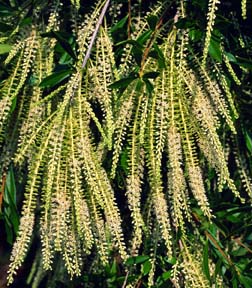 By Denny Werner, Ph.D., Director
By Denny Werner, Ph.D., Director
Cyrilla racemiflora L. and its small-leafed relative, Cyrilla racemiflora var. parvifolia (Raf.) E. Mur. are large shrubs to small trees that offer ease of culture, semi-evergreen to evergreen foliage, attractive bark, distinct architecture, summer flowering, and attractiveness to insects. Because both species suffer from the curse of not being in flower during the spring garden center frenzy, they are typically not included in the repertoire of early-season nursery and garden center offerings. Both are deserving of greater use. According to the Royal Horticultural Society Dictionary of Gardening, C. racemiflora is the only recognized species in the genus Cyrilla.
Alan Weakley, from the University of North Carolina Herbarium, in his March 4, 2005 working draft of the Flora of the Carolinas, Virginia, and Georgia, recognizes C. parvifolia Rafinesque as a true species, but states "its taxonomy is problematic." C. arida, described as native to a restricted area in the Sandhills of central Florida, is no longer recognized as a species.
C. racemiflora is unusual in having an extraordinarily wide native range, from eastern Virginia southward to Florida and west to Texas and extending south into the West Indies, Belize, Mexico, and northern South America. This interesting native range suggests that Cyrilla was displaced southward during the last North American glaciation event, and has been moving north in the past 15,000 years.
Cyrilla is a member of the family Cyrilliaceae, containing only one other genus, Cliftonia. Minor differences in leaf venation, flower (raceme) position, and fruit morphology distinguish the two genera. Commonly called "swamp cyrilla,"leatherwood," or "summer titi," cyrilla is typically found in moist to wet sites in the wild, although it is highly adaptable to a wide range of garden settings.
Typically suckering, cyrilla is best used in naturalistic landscape settings where it can spread and mingle with its neighbors. However, it also can be used effectively in a more formal setting by growing it as a single or multi-stemmed small tree. Grown in this way, the twisted stems and beautiful bark, smooth on young trees, becoming shallowly furrowed with age, are accentuated. When grown as a small tree, it can be used effectively to soften the corner of a building or house. According to Michael Dirr's Manual of Woody Landscape Plants, these taxa are hardy from Zones 5 to 11.
C. racemiflora is deciduous to semi-evergreen in my Zone 7 garden in Raleigh, North Carolina. Leaves are glossy green, about 2" to 4" long and 0.5" to 1" inch wide, and slightly smaller on C. racemiflora var. parvifolia. The beautiful white flowers, borne in 3" to 6" long pendulous racemes, convey a sense of delicacy and airiness, particularly on C. r. var. parvifolia. Usually coming into flower in late June in Zone 7, the flower display graces the garden for about four weeks. Although flowering almost three months after vegetative bud break in the spring, careful observation will show that flowers are borne in a horizontal whorl on the terminal end of shoots formed the previous year at the juncture of one-year-old wood and new growth. Fourteen-year old specimens of C. r. var. parvifolia are 8' to 10' tall in my garden, with about equal spread. The species is slightly larger.
In my home landscape, I have interplanted cyrilla with Ilex 'Winter Red', one of the wonderful deciduous, winterberry hollies. This naturalistic planting attracts numerous birds, and provides a year-round ornamental display. The stunning winterberry holly steals the show in winter with its remarkable display of berries on bare stems, accentuated by the green foliage of the cyrilla. In summer, the lustrous green foliage and the snow-like cloud of flowers on the cyrilla draw raves from visitors, while the holly recedes into the background. This large planting, positioned at the corner of my property where it can be seen from the road by passing motorists, garners considerable attention.
To my knowledge, no named cultivars are readily available; however, at least two cultivars have been selected. Bob McCartney of Woodlanders Nursery, Aiken, South Carolina, selected a weeping or prostrate form named 'Graniteville' for the town near which it was found. John Ruter, Ph.D., of the University of Georgia Coastal Plain Research Station in Tifton, Georgia, discovered a variegated form in southern Georgia which has heavily mottled, almost white new growth that changes to green during the growing season. He named it 'Spring Cloud' and is in the process of sending it out for distribution. At the North Carolina Association of Nurserymen's recent Green and Growin' Show, Ted Stephens described another selection with "outstanding variegation on new growth which slowly fades throughout the growing season." Ted related that the flowers are "lost in the variegated foliage."
In addition to the outstanding ornamental attributes of cyrilla, it has more to offer the gardener. When in flower, cyrilla attracts an incredible bounty of insects. In early July, a survey conducted by a former colleague, entomologist Mike Stanghellini, Ph.D., and myself, revealed remarkable insect diversity on cyrilla flowers: 22 different insect species were hard at work! These included honey, colletid, andrenid, and megachilid bees; potter, paper, eastern sand, great golden digger, and ichneumonid wasps; Pennsylvania leather-wing, ladybird, and Japanese beetles; soldier, hover, robber, bee, green bottle, and tachinid flies; eastern boxelder bug; vine borer; and yellow and black swallowtail butterflies. If you have ever grown mountain mint in your garden (Pychnanthemum sp.), you would observe a similar repertoire of insect guests.
Who cares, you say? Appreciate that the larvae and/or adults of 12 of these insect visitors are parasitic or predaceous on other insect species, many of which are common garden pests, including aphids, grasshoppers, beetles, and various caterpillars. Hence, inclusion of cyrilla in the home landscape attracts many beneficial insects that can help to naturally control common injurious garden pests. For low-cost, high-value entertainment, I like to sit under my cyrilla during full bloom and enjoy the collective humming and buzzing of hundreds of insects totally oblivious to my presence.
Entomologists aren't exactly sure why, but a sometimes-fatal malady called "blue brood" occurs in honeybee hives in situations where the bees forage on cyrilla as their predominant food source. In a garden setting where cyrilla is only a small part of a hive's feeding repertoire, this is of no concern.
Cyrilla is easily propagated from semi-hardwood cuttings taken from late May and into the summer. Naturally occurring suckers can be removed from the parent plant during the dormant season and grown off. Root cuttings also should be successful with this species, based on its propensity to naturally form suckers in the landscape.
Because cyrilla is at its best in the summer, when garden center traffic is at a low ebb, marketing the plant may be challenging. However, thoughtful promotion of its inherent beauty, ease of culture, and attractiveness to a wide range of beneficial insects should allow one to develop a market for this plant.
Riding High for Christmas Tree Research at NC State University
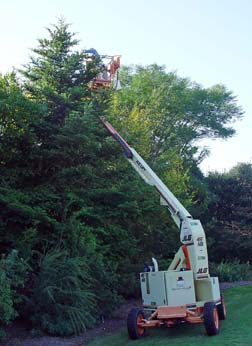 By John Frampton, Ph.D., Associate Professor and Christmas
Tree Geneticist, Department of Forestry and Environmental
Resources, NC State University and Nancy Doubrava, Interpretive
Specialist
By John Frampton, Ph.D., Associate Professor and Christmas
Tree Geneticist, Department of Forestry and Environmental
Resources, NC State University and Nancy Doubrava, Interpretive
Specialist
The JC Raulston Arboretum serves as a resource for many projects at NC State. In the Department of Forestry and Environmental Resources, the Christmas Tree Genetics Program is investigating ways to develop Phytophthora root rot resistance in Fraser fir. In a resistance screening trial of 32 Abies (true fir) species from around the world, Momi fir (Abies firma) from Japan proved to be the most resistant. During spring 2005, research technician, Anne Margaret Braham, collected pollen from a Momi fir specimen at the JCRA and John Frampton, Ph.D., used it to control-pollinate genetically improved Fraser firs grafted in a clone bank near Highlands. During the fall, the Fraser × Momi fir hybrid seeds were collected, as well as wind-pollinated seeds from the parental trees. Future research will evaluate the root rot resistance, adaptiveness, growth, and Christmas tree quality of the hybrids.
Above: Seeds of Abies firma (Momi fir) are collected at the Arboretum for Christmas tree research by Anne Margaret Braham, Department of Forestry and Environmental Resources research technician.
Tales from a New Bed
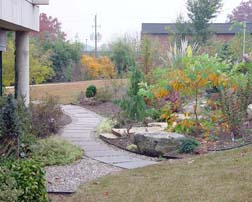 By Cheryl Doyle Kearns, Landscape Designer
By Cheryl Doyle Kearns, Landscape Designer
While visiting the JCRA one day in January, Chris Glenn and I started discussing some of the plants outside his office window. This hillside bed and level area at its base are south-facing and are viewed as you walk from the parking lot toward the Ruby C. McSwain Education Center, on the right and just outside the office spaces. Most of this planting was done in the latter half of 2003 by Todd Lasseigne, Ph.D., and Jon Roethling, and contains some unique specimens.
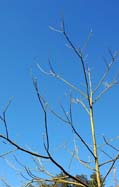 One that caught my eye was a Sassafras tzumu, the
Chinese version of our native sassafras. This tree, donated by
Forestfarm in Williams, Oregon, holds its three-lobed leaves
until late into the fall, when the foliage exhibits a colorful
yellow and orange range. Its winter form is striking for the
way the branches show off a muted yellow color and the tips at
elongated branches are upswept in a quite majestic gesture.
This tree is a fast grower, having added about 3' in the 2005
season – only two years after having been planted.
One that caught my eye was a Sassafras tzumu, the
Chinese version of our native sassafras. This tree, donated by
Forestfarm in Williams, Oregon, holds its three-lobed leaves
until late into the fall, when the foliage exhibits a colorful
yellow and orange range. Its winter form is striking for the
way the branches show off a muted yellow color and the tips at
elongated branches are upswept in a quite majestic gesture.
This tree is a fast grower, having added about 3' in the 2005
season – only two years after having been planted.
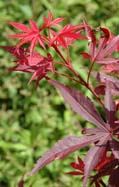 Never one to resist a Japanese maple, I also noticed the
purple bark on Acer palmatum 'Shaina'. This dwarf is
also known for the bright red color of emerging leaves that
evolve to maroon hues, thus forming a kaleidoscope of reds all
summer. Fall leaves turn crimson red before dropping to expose
the rich purple branches. A multitude of leaves, resembling red
shooting stars, form at the tip of each branch. A witch's broom
of Acer palmatum 'Bloodgood', this mounding dwarf will
reach only 4' in ten years. Thanks to the donation by Gossler
Farms, Springfield, Oregon, we can watch major fireworks on a
small shrub.
Never one to resist a Japanese maple, I also noticed the
purple bark on Acer palmatum 'Shaina'. This dwarf is
also known for the bright red color of emerging leaves that
evolve to maroon hues, thus forming a kaleidoscope of reds all
summer. Fall leaves turn crimson red before dropping to expose
the rich purple branches. A multitude of leaves, resembling red
shooting stars, form at the tip of each branch. A witch's broom
of Acer palmatum 'Bloodgood', this mounding dwarf will
reach only 4' in ten years. Thanks to the donation by Gossler
Farms, Springfield, Oregon, we can watch major fireworks on a
small shrub.
 Another plant we discussed was
×Sinocalycalycanthus 'Venus', a shrub that
elicited keen interest because it was released by Tom
Ranney, Ph.D., from the Mountain Horticultural Crops
Research and Extension Center in Fletcher, North Carolina. This
hybrid sweetshrub has large (to 5"), white, fragrant flowers
reminiscent of a magnolia's in form. It performs best with a
little afternoon shade, reaching a size of roughly 6' high and
wide. Tom says the scent of a "mixture of melon and
strawberries" is so "alluring and seductive" that Venus seemed
an obvious name for this new hybrid. Thanks to Tom Ranney's
donation, the JCRA has a goddess in their garden.
Another plant we discussed was
×Sinocalycalycanthus 'Venus', a shrub that
elicited keen interest because it was released by Tom
Ranney, Ph.D., from the Mountain Horticultural Crops
Research and Extension Center in Fletcher, North Carolina. This
hybrid sweetshrub has large (to 5"), white, fragrant flowers
reminiscent of a magnolia's in form. It performs best with a
little afternoon shade, reaching a size of roughly 6' high and
wide. Tom says the scent of a "mixture of melon and
strawberries" is so "alluring and seductive" that Venus seemed
an obvious name for this new hybrid. Thanks to Tom Ranney's
donation, the JCRA has a goddess in their garden.
 If it's fragrance you want, add a Leptodermis
oblonga to your collection. It more than compensates for
its unimpressive winter attire by putting on a continual show
of lavender-purple lilac-like blooms from June until a
determined Jack Frost hits it. This compact, mounding, 12"-18"
shrub, donated by Spring Meadow Nursery, Grand Haven, Michigan,
attracted rave reviews last year from JCRA staff. It breezed
right through the drought, blooming prolifically. Because of
its small size (spread is 18"-24") and dainty texture, it would
look as good in a container as in the border, and it isn't
fussy about soil. If you want more, propagation from softwood
cuttings is easy, or sow seed directly outside in the fall.
If it's fragrance you want, add a Leptodermis
oblonga to your collection. It more than compensates for
its unimpressive winter attire by putting on a continual show
of lavender-purple lilac-like blooms from June until a
determined Jack Frost hits it. This compact, mounding, 12"-18"
shrub, donated by Spring Meadow Nursery, Grand Haven, Michigan,
attracted rave reviews last year from JCRA staff. It breezed
right through the drought, blooming prolifically. Because of
its small size (spread is 18"-24") and dainty texture, it would
look as good in a container as in the border, and it isn't
fussy about soil. If you want more, propagation from softwood
cuttings is easy, or sow seed directly outside in the fall.
 Dwarf would also describe Nandina domestica 'Jaytee' Harbor Belle™. We owe thanks to Rushing Nursery,
Semmes, Alabama, for donating their introduction of a seedling
found in one of their beds. Harbor Belle™ adapts to sun
or shade, staying greener in winter in its shadier location at
the JCRA. What sets it apart, other than its petite size of
1'-2' height and spread, is that its new leaves are in shades
of pink, the foliage is thick, and it flowers heavily in late
spring to early summer, then produces small bright red berries.
It needs little attention to look good, growing happily in sun
or shade with moderate watering. Because it spreads by
underground shoots, it makes a colorful groundcover.
Dwarf would also describe Nandina domestica 'Jaytee' Harbor Belle™. We owe thanks to Rushing Nursery,
Semmes, Alabama, for donating their introduction of a seedling
found in one of their beds. Harbor Belle™ adapts to sun
or shade, staying greener in winter in its shadier location at
the JCRA. What sets it apart, other than its petite size of
1'-2' height and spread, is that its new leaves are in shades
of pink, the foliage is thick, and it flowers heavily in late
spring to early summer, then produces small bright red berries.
It needs little attention to look good, growing happily in sun
or shade with moderate watering. Because it spreads by
underground shoots, it makes a colorful groundcover.
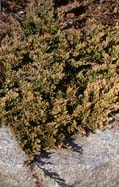 Another beautiful groundcover tucked in near a stone is Juniperus horizontalis 'Mother Lode'. The reference to
gold in the name is very appropriate, for viewed in summer, its
striking yellow hue shimmers over green undertones. In winter,
the bright color dims and the plant is equally but more subtly
appealing for the purplish-plum overlay. Planted in full sun in
well-drained soil, this slow grower will eventually spread to
8'. This sport of J. horizontalis 'Blue Rug'
has fine, long-fingered branches that remain very flat. In my
garden, it graces the edge of a stone wall, its fingers draping
gracefully over the edge. As a bonus, my four-year-old plant
pays no attention to droughts. Thanks to Wayside Gardens,
Hodges, South Carolina, for such a lovely addition to the JCRA
garden!
Another beautiful groundcover tucked in near a stone is Juniperus horizontalis 'Mother Lode'. The reference to
gold in the name is very appropriate, for viewed in summer, its
striking yellow hue shimmers over green undertones. In winter,
the bright color dims and the plant is equally but more subtly
appealing for the purplish-plum overlay. Planted in full sun in
well-drained soil, this slow grower will eventually spread to
8'. This sport of J. horizontalis 'Blue Rug'
has fine, long-fingered branches that remain very flat. In my
garden, it graces the edge of a stone wall, its fingers draping
gracefully over the edge. As a bonus, my four-year-old plant
pays no attention to droughts. Thanks to Wayside Gardens,
Hodges, South Carolina, for such a lovely addition to the JCRA
garden!
 While foliage color is always a valued attraction, so is
form. The narrow draping look of Xanthocyparis
nootkatensis 'Jubilee' draws the eye in any season. This
Alaskan cedar is a gift from Hawksridge Farms, Hickory, North
Carolina. An extremely narrow weeping form above wider
branching at its base, this bright green Alaskan cedar would
point heaven-ward in a sunny location on the corner of a house,
and the owner wouldn't need to wait long for this fast grower
to reach its ultimate height of 10'-15'. In winter, color again
comes into play as the tone becomes nearly blue.
While foliage color is always a valued attraction, so is
form. The narrow draping look of Xanthocyparis
nootkatensis 'Jubilee' draws the eye in any season. This
Alaskan cedar is a gift from Hawksridge Farms, Hickory, North
Carolina. An extremely narrow weeping form above wider
branching at its base, this bright green Alaskan cedar would
point heaven-ward in a sunny location on the corner of a house,
and the owner wouldn't need to wait long for this fast grower
to reach its ultimate height of 10'-15'. In winter, color again
comes into play as the tone becomes nearly blue.
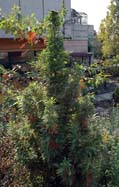 For unusual shapes, I was attracted to Taxodium
distichum 'Peve Minaret'. It isn't the shape of the
overall plant, which is generally pyramidal, that my eye
focused on, but the tip of the leader, which has developed a
thick fan shape known as fasciation. If you are familiar with
the annual commonly called cock's comb, then you can picture
this. An indication that you should expect fasciation is often
revealed in a plant's name when "cristata" or "crested" is
included. Fasciation is uncommon but not rare on 'Peve
Minaret', according to Pat McCracken of
McCracken's Nursery, Zebulon, North Carolina. The one at the
Arboretum only began exhibiting this growth habit in 2005, and
the tree has grown rapidly from about 10" at planting time to
4' now. Pat says he has tried unsuccessfully several times to
reproduce a fasciated 'Peve Minaret' bald cypress by means of
grafting. Many thanks to Coenosium Nursery, Eatonville,
Washington, for the opportunity to enjoy a fun specimen!
For unusual shapes, I was attracted to Taxodium
distichum 'Peve Minaret'. It isn't the shape of the
overall plant, which is generally pyramidal, that my eye
focused on, but the tip of the leader, which has developed a
thick fan shape known as fasciation. If you are familiar with
the annual commonly called cock's comb, then you can picture
this. An indication that you should expect fasciation is often
revealed in a plant's name when "cristata" or "crested" is
included. Fasciation is uncommon but not rare on 'Peve
Minaret', according to Pat McCracken of
McCracken's Nursery, Zebulon, North Carolina. The one at the
Arboretum only began exhibiting this growth habit in 2005, and
the tree has grown rapidly from about 10" at planting time to
4' now. Pat says he has tried unsuccessfully several times to
reproduce a fasciated 'Peve Minaret' bald cypress by means of
grafting. Many thanks to Coenosium Nursery, Eatonville,
Washington, for the opportunity to enjoy a fun specimen!
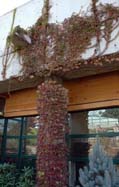 The
Arnold Arboretum's Peter Del Tredici,
Ph.D., hit a home run when he discovered Parthenocissus
tricuspidata 'Fenway Park' on the wall of the "Green
Monster," the Boston ivy-covered wall inside the ball park.
This sport (the plant, I mean) emerges bright gold and retains
its cheery color in sun or shade all summer on leaves that can
measure up to 8" wide. As if in tribute to the playoffs, the
fall foliage takes on red overtones. Like a Red Sox fan, you
need a strong constitution to grow this climber, for it can
reach up to 50' in length and spreads indeterminately. Along
Interstate 440, on part of our own "Green Monster," Boston ivy
covers a large section, where its blazing red fall foliage
becomes a near traffic stopper. The crowd roars its approval of
Plant Delights Nursery, for its donation of golden Boston
ivy.
The
Arnold Arboretum's Peter Del Tredici,
Ph.D., hit a home run when he discovered Parthenocissus
tricuspidata 'Fenway Park' on the wall of the "Green
Monster," the Boston ivy-covered wall inside the ball park.
This sport (the plant, I mean) emerges bright gold and retains
its cheery color in sun or shade all summer on leaves that can
measure up to 8" wide. As if in tribute to the playoffs, the
fall foliage takes on red overtones. Like a Red Sox fan, you
need a strong constitution to grow this climber, for it can
reach up to 50' in length and spreads indeterminately. Along
Interstate 440, on part of our own "Green Monster," Boston ivy
covers a large section, where its blazing red fall foliage
becomes a near traffic stopper. The crowd roars its approval of
Plant Delights Nursery, for its donation of golden Boston
ivy.
The above are just a few of the varied specimens outside the office windows. This assemblage of textures, color, and heights exhibited in such a delightful blend of rare evergreen and deciduous plants sent me on a hunt through numerous catalogs and Web sites in search of selections for my own garden. Next time you pass this collection, see what you "must" have for yourself!
Passionflowers: A Closer Look
 |
 |
By Tim Alderton, Research Technician
Thinking ahead to summer, thoughts of one of my favorite plants come to mind: the passionflower. You are probably familiar with the two native species, Passiflora incarnata, the maypop, and Passiflora lutea, the wild yellow passionflower. These may have a reputation for being garden weeds, rambling over other more highly prized plants and persistently popping up when supposedly pulled, but a closer look at their intricate flowers may make one reconsider.
These native species have the same floral anatomy as the rest of the approximately 500 species, found in North America and South America and a few disjunct species in the south Pacific as well as hundreds of hybrids. The flowers are composed of three leaf-like bracts that protect and enclose the developing flower. All but a few species have five sepals that may be the same or different color as the five petals. Above the sepals and petals is a corona of wiry and often crimped filaments. The business parts – the stamens and the pistil – are stacked in the center of the flower. You will find these same features on the more manageable species and hybrids as well. I encourage you to observe the intricate structure the next time you come across an open blossom. Individual flowers last only one day in most species but are produced over a long period, and vary in size from under an inch to over 5". Clear white, green, yellow, orange, red, purple, or blue colors may be seen in the flowers, and many are strongly scented.
All but a few species are vigorous climbers that will quickly cover a trellis or sprawl over nearby plants. Most flower quickly on new growth, allowing them to be grown as a summer annual. They also recover easily from a pruning either to control size or to "shrink" the vine for bringing inside for the winter.
Passiflora Scaerulea, the blue passionflower from Brazil, and Passiflora 'Incense', a hybrid of P. incarnata × P. cincinnata, are two other passionflowers that are hardy here. Passiflora caerulea may be semi-evergreen, but P. 'Incense' is herbaceous like its seed parent, P. incarnata. As with Passiflora incarnata, 'Incense' will spread by suckering roots and pop up in all kinds of unexpected places, but the much larger, deeper colored fragrant flowers compensate for their somewhat weedy habit. Passiflora caerulea has a similar habit, but to a far lesser extent. The easy way to control these two, of course, is to grow them in large sunken containers from which they are far less likely to escape.
Aside from the above few, there are hundreds of untested hybrids that have potential hardiness. Their parentage may include P. incarnata or P. caerulea without the maypop here, maypop there habit. Some that I have and would like to trial are P. 'Amethyst' and P. 'Star of Clevedon'. Both have P. caerulea in their lineage and may, as a result, be hardy as well. Hardy or not, all are worth growing where a fast growing vine is desired for a sunny spot. Some event adapt well to hanging baskets.
A wealth of Web sites offers more information and photographs about the symbolism of their exquisite flowers and how to grow them. One book I highly recommend is John Vanderplank's Passion Flowers which covers hundreds of species and hybrids.
Feel free to ask me about Passiflora or any other plants when you see me in the Arboretum. Maybe this summer there will be some I can show you!
Development
Planting the Seeds for Development
By Anne M. Porter, Director of Development
30th Anniversary Kicks Off at the 2006 Gala in the Garden
May 7, 2006 (Sunday)
3:00 PM-6:30 PM
The Gala in the Garden provides a distinctive opportunity to entertain your family, friends, and business associate while strolling around the gardens, perusing all the dazzling auction items. The Gala will culminate with a delicious dessert social and a special 30th anniversary program held in the York Auditorium at the Ruby C. McSwain Education Center.
Gala in the Garden Committee
Honorary Chairs
Mary Ann and Gregory Poole
Event Chairs
Linda and Tommy Bunn
Event Committee
Jill Chouinard Adams
Irma Clark
Rosemary Easton
Marty Finkel
Julie Fleming
Bev Gelvin
Adair Gibson
Jeff Glutz
Judi Grainger
Barb Kennedy
Charlie Kidder
Faye Koonce
Anita Kuehne
Becky Logan
John Logan
Linda Murphy
Marge O'Keeffe
Melissa Peden
Anne Porter
Sylvia Redwine
Janet Riddle
Janice Weedon
Denny Werner
Jan Wilson
Gala in the Garden Sponsors
(as of March 15, 2006)
Diamond Sponsor – $10,000.00
North Carolina Association of Nurserymen, Inc.
Platinum Sponsors – $5,000.00
Pender Nursery, Inc.
Mary Ann and Greg Poole
Gold Sponsor – $2,500.00
Hawksridge Farms Nursery
Silver Sponsors – $1,000.00
Bland Landscaping Co., Inc.
A Blue Hen in a Blue State
The Brickman Group, Ltd.
Carroll's Plant Center, Inc.
Century Framing, Ltd.
Gold Kist, Inc.
Becky and John Logan
Murphy Family Ventures, LLC
Taylor's Nursery, Inc.
York Simpson Underwood
Bronze Sponsors – $500.00
C. T. Wilson Construction Co., Inc.
Golden Corral Corp.
Pennington Seed Co., Inc.
Piedmont Carolina Nursery
Anne M. Porter
Leon and Mildred Simon
Turftenders Landscape Services
Georgina and Denny Werner
The Gala in the Garden is the Arboretum's main fund-raising event of the year, and the proceeds support its daily operations of teaching, research, and public garden displays. Won't you consider supporting the JCRA by becoming a Gala sponsor? For more sponsorship information, visit our Web site or contact Anne Porter at (919) 513-3463 or <anne_porter@ncsu.edu>.
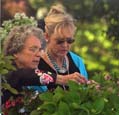 Gala in the Garden Silent Auction
Gala in the Garden Silent Auction
The silent auction is always a favorite entertainment of the Gala. Whether guests are bidding on outstanding and unusual plants, resort packages, signed memorabilia and books, concert tickets, fine handcrafted jewelry, or cigars and vintage scotch, it is guaranteed to be great fun and great competition! If you would like to donate a special item for the auction, please visit our Web site or contact Anne Porter at (919) 513-3463 or <anne_porter@ncsu.edu> for more information.
Save-the-date
The JCRA is excited to be part of the 2006 Garden Conservancy Open Days program. For more information regarding the program and to see a schedule of the 2006 Open Days gardens throughout the country, please visit their Web site at <www.gardenconservancy.org>.
The Arboretum will be selling the Open Days books for $21.00, and will receive 50% of the book sales. With a book purchase, you also receive six tickets to visit any garden featured on the 2006 tour. The Garden Conservancy Open Days books are great references for any garden lover. This is a wonderful opportunity to see many spectacular private and public gardens throughout the country while supporting the JCRA. The books should be available at the JCRA by April. Tickets may be purchased for $5.00 each the day of the event at individual gardens.
The Raleigh Open Days will be September 23 and 24, 2006. The tour features the following spectacular gardens:
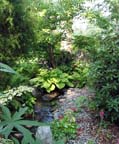 Cyndy Allison
Cyndy Allison
The gardens grace all sides of the family's 30-year-old
traditional Southern home. Innovative use of stone and brick
provide beauty (a spectacular archway), privacy (the perimeter
wall), access (meandering trails), and the architectural
foundation for the sumptuous plantings beneath the native red
and white oak canopy. Stacked stone retaining walls define the
curved confines of beds that feature plants from around the
world – the source of year-round color shows. And
finally, her water features dazzle – the formal Italian
fountain, the waterfalls cascading into multiple ponds, and the
stream that threads through patios and secluded alcoves.
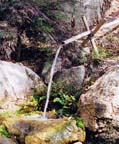 Tommy and Linda Bunn
Tommy and Linda Bunn
This splendid garden and its serene multilevel Japanese-style
setting makes it difficult to believe that it is only a little
over one acre and just off a busy street located in one of
Raleigh's premier neighborhoods. The property includes a pond
spillway that has been transformed to a magnificent water
feature that feeds into an artistically designed stream that
meanders through the garden. Plantings include flowering
shrubs, Japanese maples, willows, conifers, and many more
unique varieties of plants from the JC Raulston Arboretum's
Connoisseur Plants program. The original stone sculptures range
from the majestic to the whimsical. This garden is sure to put
everyone is a Zen state of mind!
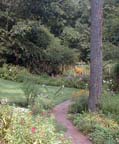 William and Mary Coker Joslin – The Joslin
Garden
William and Mary Coker Joslin – The Joslin
Garden
The Joslin Garden, in a woodland setting of four and a half
acres, has about ten distinct garden areas adapted to the
topography of a relatively native unspoiled lot. Arranged with
great sensitivity to cultural conditions, native plants are
well represented in a substantial shrub and herbaceous
perennial layer. The garden was begun around 1951 and is still
being cultivated by the addition of rare plants and collections
of similar species. Thanks to a generous life estate gift from
the Joslins, this garden is now an official satellite of the
JCRA.
 Lacy and Carol Reaves – The Reaves
Garden
Lacy and Carol Reaves – The Reaves
Garden
These immaculate, formal gardens surround a lovely
Federal-style home with a nod towards Williamsburg and
Charleston gardens. Each season unfolds different colors and
textures to keep this garden interesting year-round. The
terraced beds were added to give even more structure to these
formal beds. The rose garden courtyard is a masterpiece in
design and pleasure. The driveway perennial bed is a visual
delight, especially in the height of summer when the daylilies
nod their heads as you drive by.
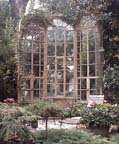 Sylvia Redwine
Sylvia Redwine
This garden combines elegant style with high drama, an
artist's eye with a collector's appetite. Clever design
strategies and theatrical hardscape elements give the garden an
illusion of size. Its dense plantings include innumerable
flowering shrubs, Japanese maples, and a fabulous collection of
unique conifers, while colorful perennials, annuals, and
tropicals add seasonal pizzazz. Expect the unexpected in this
garden!
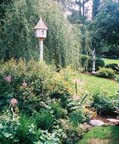 David Philbrook and Helen Yoest – Tiger Lily's
Display Garden
David Philbrook and Helen Yoest – Tiger Lily's
Display Garden
Low boxwood hedges are used to create a formal atmosphere to
complement the formal architecture of this Georgian
Colonial-style home. Within these hedges are informal plantings
of perennials and annuals designed to attract butterflies,
hummingbirds, and finches. There are several gardens on this
half-acre suburban property, including a rose garden, a front
entrance garden, a butterfly garden, a Japanese-inspired
garden, and a secret garden. These gardens lend themselves to a
variety of several light-hearted, surprising, and interesting
garden accents.
Members Making News
In April 2005, Chip Callaway was inducted into the Garden Club of America. He is the only North Carolinian ever to be inducted other than J. C. Raulston, Ph.D. Just take a look at the pictures of his work on his Web site at <www.chipcallaway.com> to see why GCA picked one of our own! Congratulations, Chip!
In January 2006, Cyndy Allison, owner of Willow Tree Landscaping in Raleigh, was recognized with the Grand Award and Best of Show by the Landscape and Grounds Management Association of North Carolina for the year 2005. The award read: "In recognition of your efforts in improving the environment for the benefit of mankind. This award commends you for promoting, protecting, and preserving the heritage of beauty for all future generations." To see more garden designs, visit <www.willowtreelandscaping.com>. Way to go, Cyndy!
Cyndy's home garden is also featured in the 2006 Garden Conservancy Open Days.
The JCRA is extremely fortunate to have so many talented friends and donors. If you have received a special horticultural or landscape award or know someone who has, please share it with us.
Leaving a Legacy...Will Bequests
Isabella Cannon, Annalise Koch, Julia Skinner, Willie York, and many others, including J. C. Raulston, had such a passion and love of the Arboretum during their lives that they made special provision in their wills to benefit the JCRA. They will not be forgotten! We thank these generous donors and all of our other friends who have included the JCRA in their estate planning. A will bequest is a practically effortless way to give, yet the impact is so important.
The Top Ten Reasons to Talk with Us about Including
a Gift for the JC Raulston Arboretum in Your
Will
10. A bequest is an easy, effective way to support the
Arboretum.
9. You can designate your gift to any JCRA program or garden
area.
8. You can create an endowment fund that will last in
perpetuity.
7. You can create a scholarship fund to help future
horticultural or landscape design students.
6. The regulations dealing with the estate tax are changing,
almost each year.
5. We can help you identify which assets are best to use in
making your gift.
4. You will become a member of the NC State University's
Pullen Society.
3. We can provide information on the best way to structure
your gift.
2. We can help plan so your gift will be used exactly as you
wish.
1. It gives us a chance to thank you for your future gift.
Ways to Give Beyond Your Membership
Outright Gifts
Includes cash, appreciated property (stock and real estate),
or tangible personal property.
Matching Gifts
Many gifts from active or retired employees qualify for
matching gifts from their employers. Please check with your
employer.
Memorial Gifts
What better way to remember or honor a loved one, friend,
business, or organization than with a special memorial tribute
gift? There are many opportunities – from an engraved
brick, to a garden bench, or a named garden. This is a gift
that keeps on giving!
Gifts of Insurance
You may specify the JC Raulston Arboretum as beneficiary of an
existing policy, or you may make a pledge by purchasing a new
whole life insurance policy and naming the JCRA as the
recipient.
For more information on these giving opportunities, please call or e-mail Anne Porter at (919) 513-3463 or <anne_porter@ncsu.edu>.
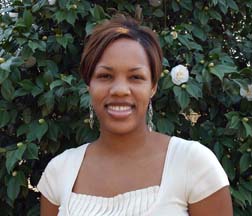 Autumn has Come Just in Time for Spring!
Autumn has Come Just in Time for Spring!
The JCRA is pleased to introduce our new associate director of membership and fund-raising events, Autumn Nicole Keck. Autumn comes to us from the American University Washington College of Law, in Washington, D.C., where she served as assistant director of annual giving. She is a graduate of NC State University, with a B.A. in communications and minor in journalism. Autumn is a skilled fund-raising professional, and we are very excited to have her join our Arboretum staff. Please call or come by the Arboretum to visit and welcome Autumn.
Programs
JC Raulston Arboretum 30th Anniversary Symposium
"Plan – and plant for a better world"
September 22-24, 2006
The JC Raulston Arboretum 30th Anniversary Symposium will celebrate the founding of the JC Raulston Arboretum at NC State University and J. C. Raulston's life through speakers drawn from colleagues, students, plant professionals, and the nursery industry, all of whom are richer from his legacy. There will be links to the past, a roundup of current plant successes, and a salute to J. C.'s influence on future plant introductions.
Speakers and More
Roy Lancaster – Keynote Speaker
"A Pocketful of Dreams – Plant Trials in a Small
Suburban Garden 1982-2006"
Roy Lancaster is a free-lance writer, plant explorer, and
broadcaster. He has written many books and regularly
contributes to various magazines including the Royal
Horticultural Society journal, The Garden. He has
worked at the University of Cambridge Botanic Gardens and the
Hillier Nurseries in Hampshire, England, before becoming the
first curator of the Sir Harold Hillier Gardens in 1970.
- Peter Del Tredici, Ph.D. – Senior Research Scientist, Arnold Arboretum
- Roy Dicks – Music and Theater Reviewer, News and Observer
- Mike Hayman – Photographer, Louisville Courier Journal
- Bill McNamara – Director, Quarryhill Botanical Garden
- Don Shadow – Owner, Shadow Nursery
- Kim Tripp, Ph.D. – Director, The New York Botanical Garden
- Bobby Ward, Ph.D. – Author and Retired Environmental Scientist
Plus:
Carolina Country Club Reception and Dinner
Live Auction with Guest Auctioneer, Tony Avent
Tours (separate registration):
Montrose, Hillsborough
Juniper Level Botanic Gardens at Plant Delights Nursery,
Raleigh
Garden Conservancy Open Days Tour of Six Raleigh Gardens
Information and Registration
For additional information, please visit the Arboretum's Web site at <www.ncsu.edu/jcraulstonarboretum> or call Chris Glenn at (919) 513-7005. Registration begins on March 27, 2006.
Calendar of Events
For more information concerning any of the Arboretum's events, please visit the Arboretum's Web site at <www.ncsu.edu/jcraulstonarboretum> or call (919) 515-3132.
Friends of the Arboretum Lecture
"In Search of the Horticultural Big Five – A
Horticultural Journey through South Africa"
Tony Avent, Plant Delights Nursery at Juniper Level
Botanic Gardens
April 20, 2006 (Thursday) – 7:30 PM
Free for members – $5.00 for
nonmembers
York Auditorium, Ruby C. McSwain Education Center,
JCRA
Take a visual journey
through South Africa with Tony Avent to see the floral wonders
in this part of the Southern Hemisphere. On trips to Africa,
people typically talk about seeing the "Big Five." This refers
to the fauna list of buffaloes, elephants, leopards, lions, and
rhinoceros. Enjoy Tony's "Big Five" from a floral point of
view, that is Agapanthus, Aloe, Brunsvigia, Haemanthus, and Kniphofia and so much more.
Gala in the Garden
May 7, 2006 (Sunday) – 3:00 PM-7:00 PM
$55.00
JC Raulston Arboretum
Join us for a delightful spring afternoon with cocktails,
gourmet hors d'oeuvres, live music, and a silent auction
featuring a plethora of unique plants and an eclectic array of
many other distinctive items. Please call Autumn Keck at (919)
513-3826 for an invitation or to register for the Gala in the
Garden.
Friends of the Arboretum Lecture
"Gardening Down Under: Gardens of Australia and New
Zealand"
Bryce Lane, Instructor and
Undergraduate Coordinator, Department of Horticultural Science,
NC State University
May 11, 2006 (Thursday) – 7:30 PM
Free for members – $5.00 for
nonmembers
York Auditorium, Ruby C. McSwain Education Center,
JCRA
A five-week trip to New
Zealand and Australia provided the opportunity to visit many
different types of gardens. From botanical gardens in
Christchurch, Sydney, Brisbane, and Melbourne, to small private
gardens frequented by some, to large national parks, Bryce had
the opportunity to see and photograph many new things. This
presentation will recount many of the wonderful experiences of
a gardener's trip down under!
JC Raulston Arboretum Summerfest –
Free
Sponsored by the Wake County Extension Service and the
JCRA
June 24, 2006 (Saturday) – 10:00 AM-3:00
PM
JC Raulston Arboretum
Bring the family to the Arboretum and learn about new plants
for your garden, soil preparation and amendment, plant
diseases, beekeeping for the homeowner, home landscape
irrigation, turf choices for the landscape, basic landscape
design principles, and other timely garden topics from NC State
faculty, Wake County Master Gardeners, and other professionals.
Tours of the garden will be available.
Keynote Speakers
Bryce Lane, NC State University and "Bryce in the
Garden"
Carl Matyac, Ph.D., Wake County Extension Service
Chris Morman, Ph.D., Extension Wildlife Specialist, NC State
University
Speakers in the Garden
Rich Cooper, Ph.D., NC State University – turf choices
for the home landscape
Bob Davis, Blue Moon Landscape Design – water
gardening
Frankie Fanelli, JCRA – summer bulbs
Bill Fonteno, Ph.D., NC State University – soil
management and understanding fertilizers
Helen Kraus, Ph.D., NC State University – home landscape
irrigation
Jonathan Nyberg and Rebecca Wellborn, Meadowsweet Gardens
– groundcovers
David Tarpy, Ph.D., NC State University – beekeeping
basics
Denny Werner, Ph.D., JCRA – annuals and perennials
A Master Gardener "Plant Clinic" will also be on site to answer all of your gardening questions.
JC Raulston Arboretum 30th Anniversary
Symposium
September 22, 23, and 24, 2006 (Friday, Saturday, and
Sunday)
$195.00
Carolina Country Club (Friday evening) and the McKimmon Center
for Extension and Continuing Education
(Saturday)
See the symposium announcement to the left for details.
Garden Conservancy Open Days
September 23 and 24, 2006 (Saturday and Sunday)
$5.00 per person per garden or $21.00 for book with
six tickets
Six Raleigh gardens
See the Open Garden Days announcement on pages 11 and 12 for
details.
Annual Plant Distribution
October 7, 2006 (Saturday)
JC Raulston Arboretum
Free for members – nonmembers must become
members
Volunteering
Volunteer News
By Frankie Fanelli, Volunteer Coordinator
JCRA volunteers contributed over 10,000 hours of their time in 2005! Every single hour contributed to the enjoyment of our visitors and freed our staff to tackle other projects. We ask for a minimum of 30 volunteer hours annually, but, as you can see from the listed below, many volunteers far exceed that number. JCRA volunteers are very special people. Here is just one example! Many volunteers took time out of their busy holiday season to help set up and take down the poinsettias for the December open house. As an extra benefit, each volunteer was able to select plants to decorate their homes. Stories quickly surfaced of the poinsettias being shared with homebound folks or nursing home residents. JCRA volunteers are a very generous lot! Thank you for all that you do for JCRA!
Let me know if you have an interest in becoming a JCRA volunteer. I will be glad to meet with you to discuss the available volunteer opportunities. I can be reached by phone at (919) 513-7004 or via e-mail at <frankie_fanelli@ncsu.edu>.
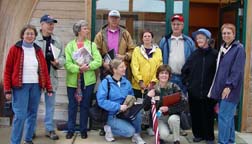 The 2006 tour season is in full swing. Public tours are
conducted Sundays at 2:00 PM from March through October.
Requests for private tours are coming in daily. The JCRA tour
guides are always ready to share their knowledge and love of
the JCRA. The above photograph taken following a recent
enrichment session shows their enthusiasm. Pictured (back row,
left to right) Kathy Crosby, Tom
Bumgarner, Genelle Dail, Charlie Kidder, Catherine
Poff, Roland Flory, Vivian
Finkelstein, and Kathe Rauch; (front
row, left to right) Gail Harris and Barbara Kennedy. Thank you guides – for
your dedication!
The 2006 tour season is in full swing. Public tours are
conducted Sundays at 2:00 PM from March through October.
Requests for private tours are coming in daily. The JCRA tour
guides are always ready to share their knowledge and love of
the JCRA. The above photograph taken following a recent
enrichment session shows their enthusiasm. Pictured (back row,
left to right) Kathy Crosby, Tom
Bumgarner, Genelle Dail, Charlie Kidder, Catherine
Poff, Roland Flory, Vivian
Finkelstein, and Kathe Rauch; (front
row, left to right) Gail Harris and Barbara Kennedy. Thank you guides – for
your dedication!
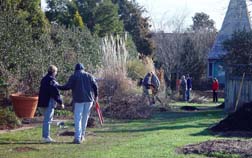 The weekend/evening gardening group works all year long. The
photograph above shows them at work in the Perennial Border on
a Saturday morning in late January. Working with this gardening
group is just one volunteer option for folks that work through
the week.
The weekend/evening gardening group works all year long. The
photograph above shows them at work in the Perennial Border on
a Saturday morning in late January. Working with this gardening
group is just one volunteer option for folks that work through
the week.
Volunteer Hours
December 2004-November 2005
Thank you to all volunteers that shared their time and talents in 2005. Your volunteer contribution makes the JCRA a better place!
300-400 Hours
Carolyn Fagan
Vivian Finkelstein
250-300 Hours
Tom and Marie Bumgarner
Bob Davis and Judy Morgan-Davis
200-250 Hours
Mary Edith Alexander
Virg Birkin
Claude and Mary Caldwell
Barbara Kennedy
Charlie Kidder
150-200 Hours
Rudy and Rikki Machilek
Jean Mitchell
Laddie and Edna Munger
Charlotte Presley
Heather Siekkinen
Dora Zia
100-150 Hours
Patrice Cooke
Linda Glenn
Margaret Jordan
Amelia Lane
Mary McClure
John Schott
Elaine Pace
50-100 Hours
Rosanna Adams
Harvey Bumgardner
Anne Clapp
Sherman Criner
Laurie Cochran
Colin Daniels
50-100 Hours Continued
Suzanne Edney
Wendy Elliott
Wayne Friedrich
Tim Hinton
Anita Kuehne
Carol Lawrence
Janet Riddle
Bob Roth
Judy Ryan
Bill Satterwhite
Ann Stellings
Ann Swallow
Dee Welker
David White
Bobby Wilder
Bill and Lib Wilder
30-50 Hours
Jeanne Andrus
Jayme Bednarczyk
Rick Boggs
Mary Button
Brenda Cleveland
Monika Coleman
Dave Duch
Annie Hibbs
Marty Howard
Beth Jimenez
Sarah Marano
Marianne Mott
Dick Pearson
John Pelosi
Kathe Rauch
Martha Ramirez
Sandy Reid
Nancy Simonsen
Betsy Viall
Qian Wu
JCRA T-shirts
The 2006 JCRA T-shirt is now available! This year's design celebrates the JCRA's 30th anniversary as well as J. C. Raulston's legacy. J. C.'s tag line "Plan – and plant for a better world" is include in the design. T-shirts may be purchased at the Arboretum for $15.00 and $20.00. Profits from the sale of apparel help support the JCRA volunteer program.
Guided Tours
Arrangements may be made for guided tours for adult parties of ten or more by calling Faye Koonce at (919) 513-7457. One month's notice is required. There is no fee, but donations to support the Arboretum are always appreciated.
Formatted into HTML by Christopher
Todd Glenn
Programs and Education Coordinator
JC Raulston Arboretum
Department of Horticultural Science
North Carolina State University
Raleigh, NC 27695-7522
© The JC Raulston Arboretum, April 2006

